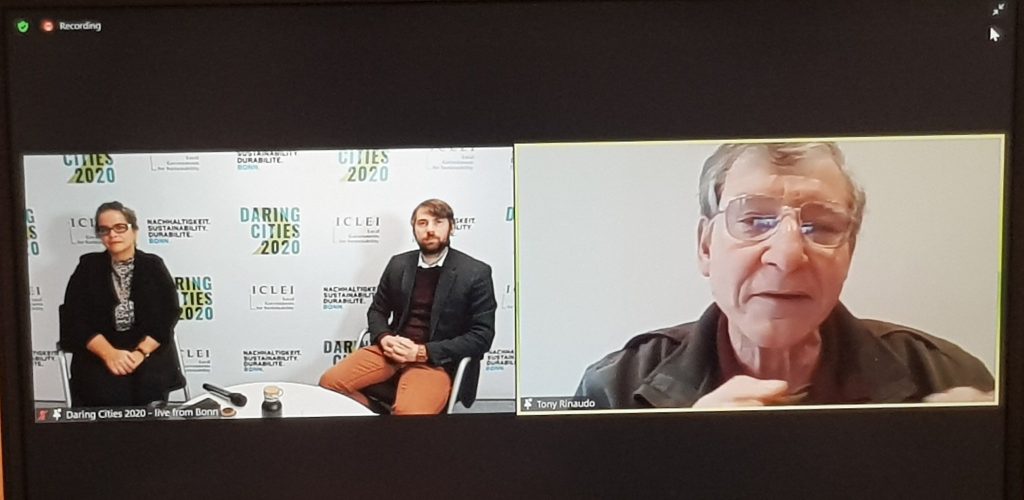
On October 8, Right Livelihood Award Laureate Tony Rinaudo spoke at the opening session of the @Bonnglobal series at Daring Cities 2020.
Rinaudo, who received the Right Livelihood Award in 2018, not just talked about his mission and work, but was also eager to answer questions from the audience.
Owing to the time limitation, not all audience questions could be heard. Therefore, Tony took some time to answer some more questions which were raised during the session.
When working in areas with tree planting NGOs, are you working closely with them, or do you work with other local communities or other geographic conditions in the country? (cooperation or complementing?)
It depends on the situation whether we are able to work with them or not. As a rule, when I conduct an FMNR training workshop I ask that as many organizations and government departments as possible and that are interested participate. We do have projects that have partners and both FMNR and tree planting are implemented, and as far as possible I try to design projects which have as an objective to reach and train other organizations, even if they are not formally a part of the project.
What role do you see for policy-makers in this work?
Policy makers can play an important role. In many countries existing policies discourage farmers and communities from taking responsibility for tree restoration and sustainable management. These laws need to be changed. Other countries actually have excellent environmental policies but they are not enforced and few people who need to know about them are actually aware of them. So, the role I see for policy makers is to create ‘enabling’ policies which encourage tree restoration and management, and to ensure that the population is informed about these policies and that they are actually enforced.
As far as I understand, the regenerating reforestation is based on existing roots, right? What do you think, how long can roots in the soil survive? Does the method work also in deserts?
The method is based on regenerating tree stumps and roots and seeds in the ground. When behaviours change such as the way livestock and fire are managed and if and how woody biomass is harvested and the way land is prepared for agriculture (ploughing), then nature will have a chance to begin to heal e.g. when fire is suppressed, or used judiciously, when livestock are not allowed to graze the same area 100% of the time, when people agree not to harvest all woody biomass and when farmers choose not to plough every square inch of land, then seeds and root systems in the ground can grow again. Additionally, this change behaviour gives nature a chance to bring seed in from other areas via wind, water, birds, livestock and wild animals – and when the seed arrives, it will have a better chance of survival.
I do not know how long these tree stumps and roots can survive in the soil, but I believe it could be well over 100 years.
In regards to deserts – it depends on what was there previously. If there was a forest in the past, then chances are that it will work there. In Somaliland, I have seen FMNR work well with as little as 100-200 mm rainfall. The tree stumps and seeds are there. People agreed to keep livestock out of a set area and the trees grew! This does not mean that every desert has stumps and seeds, but in my experience, many deserts are not lifeless wastelands – they are altered landscapes which have had their vegetation removed and the continuous pressure of livestock and biomass harvesting is preventing restoration of the vegetation. I have seen sprouting trees in very arid parts of Jordan, Abu Dhabi and Dubai and friends working in Saudi Arabia have reported living tree stumps there. If you google aerial photos of these countries you will see a surprising number of “bushes” and even isolated trees. This is very similar to what Niger looked like when I first went there. A sentinel begs the questions – where did it come from? How did it survive? If one could grow, why not more? was there once a forest here? What would need to be done to encourage other trees to grow here? And, when I see ‘bushes’ in the desert, I ask myself – are they really bushes, or are they trees which were cut down which have resprouted?
How to deal with topics such as land access, property, and tenancy to implement your reforestation strategy in a context of inequality to access and use of natural resources and land?
This is a very important question and the ‘how’ will depend on the country and context. People need a basic assurance that they will benefit from their efforts to restore trees, or else, in most cases they will not do this unless paid to do so. Thus, a big part of the projects we design is to ensure at the outset that individuals and communities will have either outright ownership or at the very least, legally binding user rights of the trees they grow. This could be as simple as getting village or county level agreements but sometimes it will require policies to change at the national level.
Interestingly, in Niger, policies did not change until 20 years after FMNR began to be adopted! People began to care for trees on the ‘perception’ that the trees now belonged to them. This was related to district level informal agreements, a weakening of the state’s ability to pay forest guards who used to traverse the country side fining people for cutting trees and the advent of democracy, which people interpreted to mean “we can now do what we want”.
Can you tell a little more in detail how to deal with the water scarcity in mountainous areas.
A Permaculture principle is to keep water as high on the mountain for as long as possible. This can be done by restoring vegetation which helps water infiltrate into the soil more quickly rather than flowing downhill immediately after rain, and by over time, building up soil organic matter in the soil. This organic matter acts as a natural sponge holding water longer in the soil profile and releasing it over time.
In addition, people can dig / construct water harvesting structures such as contour banks, small dams, zai pits (small planting pits which catch water) and half-moons (semi-circle holes designed to trap water). All of these structures stop water from running straight down hill and give it more time to sink into the ground. In some hilly areas sand dams have become popular. A dam wall is created and over time, the uphill side of the wall fills with sand and sediment. Even though it does not hold as much water as a dam filled with water, there is still a lot of water stored in the pores between the grains of sand. Sand dams also lose less water to evaporation.
